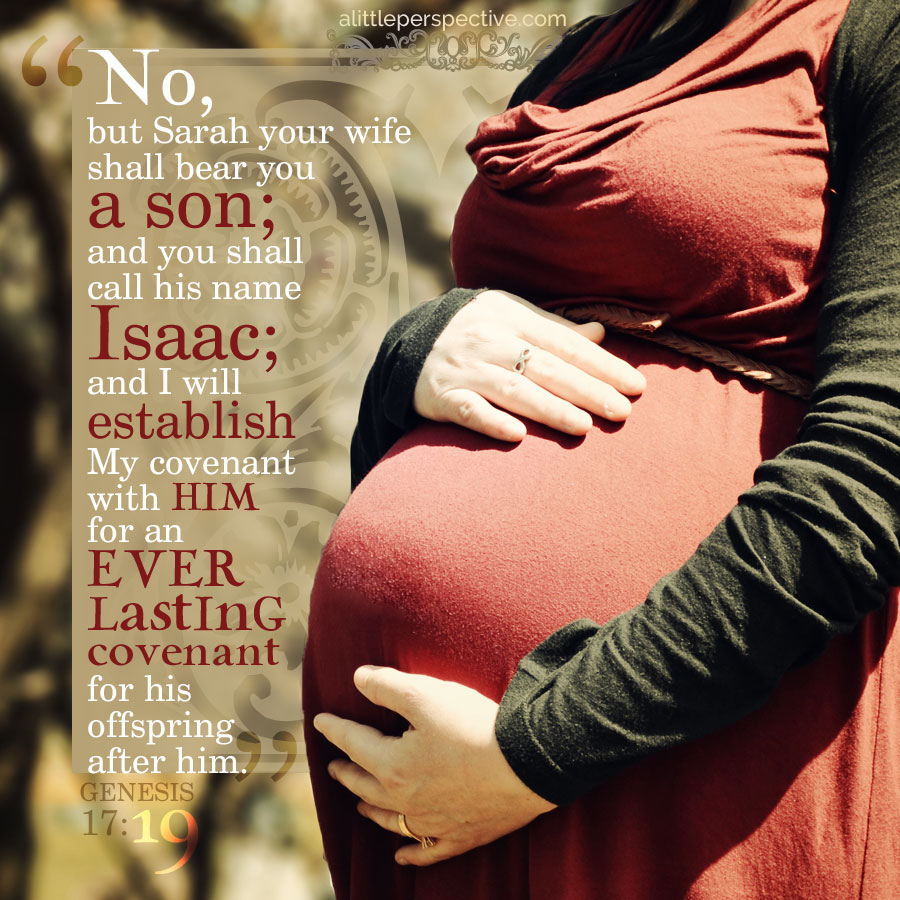Read Genesis 17:15-27 at Bible Gateway.
Hebrew paragraph division
Gen 17:15-27 {p} Promised seed through Sarah (Isaac)
Gen 17:1-27 {s+p} reverse parallelism
1a) Gen 17:1-14 {s} The covenant reaffirmed/ circumcision, the sign of the covenant, given;
1b) Gen 17:15a And Elohiym said to Abraham;
1c) Gen 17:15b-16 You shall call your wife Sarah/ I will bless her + give you a son by her;
1a) Gen 17:15b Elohiym: As for Sarai your wife, her name shall be Sarah;
1b) Gen 17:16a And I will bless her;
central axis) Gen 17:16b And moreover I will give you a son by her;
2b) Gen 17:16c I will bless her;
2a) Gen 17:16d And she shall be a mother of nations; kings of peoples shall be of her;
1d) Gen 17:17-19b That Ishmael might live before You/ Your wife Sarah shall bear your son Isaac;
1a) Gen 17:17a Abraham fell on his face + laughed/ Shall a child be born to him that is 100 years old?
1b) Gen 17:17b Shall Sarah, that is 90 years old, bear?
central axis) Gen 17:18 Abraham to Elohiym: Oh, that Ishmael might live before You!
2b) Gen 17:19a Elohiym said: No, but Sarah your wife shall bear you a son;
2a) Gen 17:19b And you shall call his name Isaac;
2d) Gen 17:19c-21a I will bless Ishmael/ My covenant I will establish with Isaac;
1a) Gen 17:19c I will establish My everlasting covenant with him + his offspring after him;
central axis) Gen 17:20 And as for Ishmael, I have heard you; behold, I have blessed him, and will make him fruitful, and will multiply him exceedingly; twelve princes shall he beget, and I will make him a great nation;
2a) Gen 17:21a But My covenant will I establish with Isaac;
2c) Gen 17:21b Whom Sarah shall bear to you at this set time in the next year;
2b) Gen 17:22 And He left off talking with him + Elohiym went up from Abraham.
2a) Gen 17:23-27 {p} Abraham circumcised his house that selfsame day.
I cannot see that the single paragraph, Gen 17:15-27, makes a chiastic structure by itself; it needs to be joined to the previous paragraph (Gen 17:1-14 {s} circumcision, the sign of the covenant, given) to make a structure. Verse 19 is in the center of the D pair:
And Elohiym said: “No, but Sarah your wife shall bear you a son; and you shall call his name Isaac; and I will establish My covenant with him for an everlasting covenant for his offspring after him.” Gen 17:19
Verse 18 and 20, which surround it, are the central axis’ of each D pair concerning Ishmael. The form of this structure then creates a double highlight on Ishmael and Isaac. The greater message of Scripture is that the covenant of God and Abraham is through the son of the promise, Isaac, and not the son of the flesh, Ishmael. The structure is highlighting Isaac as the promised seed, connecting it by common theme to Gen 3:15.
Original Hebrew
Sarah is Strong’s H8283, Sarah, a proper name, from Strong’s H8323, sarar, a primitive root, “to be prince, to hold dominion.”
The ancient Hebrew pictographs are of the shin + resh + resh (according to Dr. Jeff Benner in The Ancient Hebrew Lexicon, the shin in sarar was originally a sin, which was transposed over time):
sin = the thorn, thus grab, hate, protect
resh = the head of man, thus head, first, top, beginning, man
resh = the head of man, thus head, first, top, beginning, man
The thorn can represent a turning, as when someone encounters a thorn in the path and turns from it to go another direction. The story the ancient pictographs are painting of a ruler is one who turns (sin) men (resh x2) to his direction; i.e. one who influences others either by force or persuasion.
Isaac is Strong’s H3327, Isaac, a proper name, from Strong’s H6711, tsachaq, a primitive root, “to laugh.”
The ancient Hebrew pictographs are of the tsadey + chet + quph:
tsadey = the trail, thus a man concealed, journey, chase, hunt
chet = the wall, thus outside, divide, half
quph = the sun on the horizon, thus condense, circle, time
The belly is to the body as a wall is to the house. Even today we still call the front of the belly, the abdominal wall. It is the only part of the body called a wall, and this is from ancient days. The story the ancient pictographs are painting of a laugh, is that which journeys (tsadey) from the belly (wall, chet), so that the mirth of the heart is condensed (quph) into its sound.
Further study off site
Hebrew names in the Torah (Broken link, active January 30, 2017) – Dr. Jeff Benner

















Leave a Reply